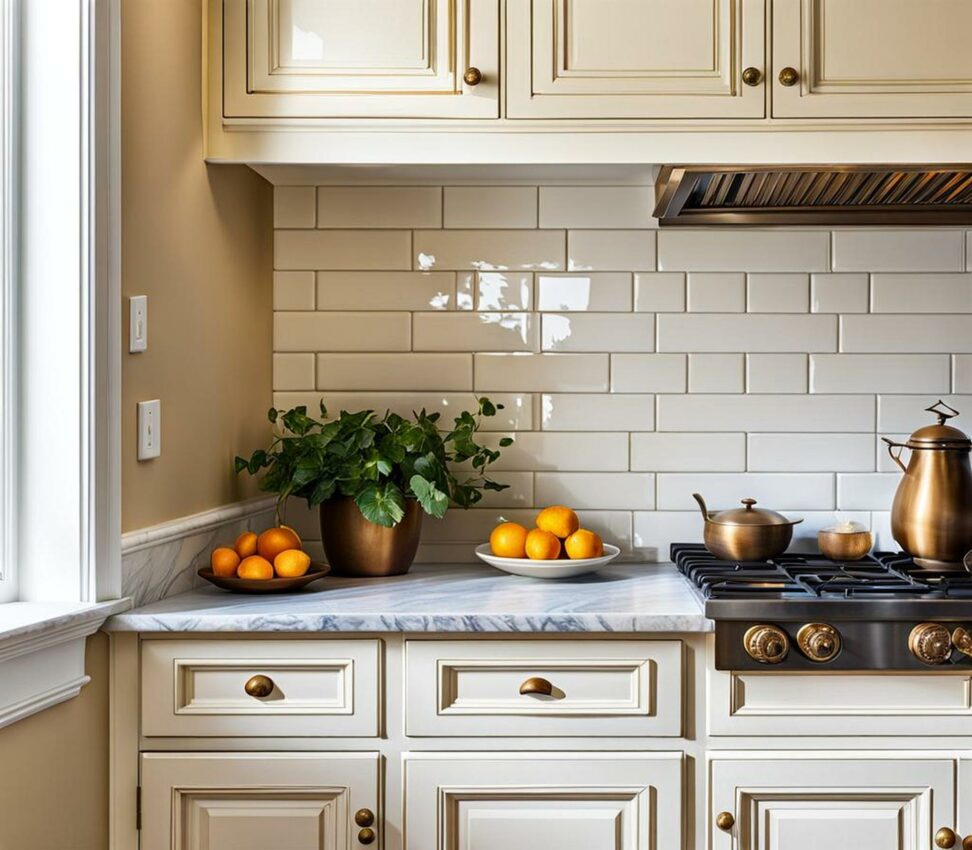Get the Inside Scoop on Antique White Kitchen Cabinets
Antique white kitchen cabinets offer a timeless appeal that instantly warms up a kitchen. The distressed detailing lends rustic character, while the muted off-white paint provides a relaxed, welcoming backdrop. If you're intrigued by this cozy vintage trend, read on to learn the styling secrets that give antique white cabinets their charming farmhouse vibe.
With clever design choices, you can easily capture the essence of antique white cabinets. From the paint finish to the hardware, each element works together to create a light and airy look with just enough imperfection. While brilliant white cabinets can feel sterile, the soft antique white color feels more subdued. The slight yellow undertones add warmth, evoking the comfort of an old country kitchen. When paired with modern brushed nickel hardware, subway tile, and pops of contrasting color, the traditional cabinets feel fresh rather than dated.

What Makes Cabinets “Antique White”
So what exactly qualifies kitchen cabinets as antique white? Here are a few of the definitive characteristics:
- Light, off-white paint color, not stark white
- Muted, slightly yellowed, with beige undertones
- Distressed paint and glazes create an aged, timeworn look
- Vintage-style hardware like bronze pulls or porcelain knobs
Rather than a flat, perfect white, antique white has more depth. The aged, almost weathered appearance gives antique white cabinets warmth and personality. Strategic distressing like rub-throughs and chips showcase the wood grain underneath for extra character.
Achieving the Distressed Look
Several techniques can help you distress cabinets for an antiqued look:
- Sanding or scraping paint to reveal wood underneath
- Glazing and wiping to create worn, variegated spots
- Applying gel stains to edges and corners for depth
The key is applying these effects methodically so the wear patterns look natural, not haphazard. Finish with a clear matte coat for protection.
The Broad Appeal of Antique White Cabinets
What makes antique white cabinets so popular in today's kitchens? Here are a few of the reasons this versatile look attracts a range of homeowners:
Warm, Relaxed Ambiance
The light, muted antique white color feels more casual and inviting than stark white. Rather than a cold, sterile impression, antique white evokes the comforts of a country cottage. Delicate distressing adds to the relaxed charm.
Suits Any Design Style
From modern to traditional, antique white cabinets pair well with a variety of styles. Their versatility allows mixing eclectic elements, like subway tile backsplash with farmhouse hardware. The soft white backdrop lets other colors shine.
Budget-Friendly Update
Painting outdated oak or maple cabinets is an easy, affordable way to revive a kitchen's look. The soft white provides a fresh blank canvas, while distressing hides existing flaws or damage. Minor repairs, new hardware, and a coat of paint can make old cabinets look custom.
Design Tips for Antique White Kitchens
Certain design choices complement antique white cabinets' vintage style. Here are some elements to incorporate for a cohesive look:
Butcher Block or Marble Countertops
Wood butcher block or white marble countertops offset antique white cabinets beautifully. The natural patterns and textures balance the painted finish. Quartzite, soapstone, and cream granite are other fitting options.
Black Iron Hardware
Swapping old hardware for vintage black iron or porcelain knobs and pulls aligns with the antique white aesthetic. Aim for an eclectic, mismatched look, mixing in brass or nickel for contrast.
Exposed Beam Lighting
Hanging pendants, chandeliers, and sconces with visible filament bulbs complement both traditional and modern kitchens. The Edison bulbs' visible insides enhance the antique vibe.
Achieving the Antique White Look
Transforming your kitchen with antique white cabinets requires careful preparation and painting. Here are some tips for success:
Prepare Cabinets Thoroughly
Remove doors and hardware. Fill any holes and sand surfaces smooth. Clean thoroughly with TSP substitute to remove grease and grime so paint adheres well.
Prime and Paint Multiple Coats
Prime first for better coverage. Apply at least two coats of antique white cabinet paint, sanding lightly between each. Thin layers create a smooth finish.
When paint has cured per label instructions, add distressing. Lightly sand edges and corners to break through paint. Add glazing for an aged look.
With the right approach, it’s simple to give your kitchen a farmhouse face-lift with antique white distressed cabinets. Pay attention to the small details that capture the vintage spirit, and you’ll enjoy this stylish but cozy look for years to come.